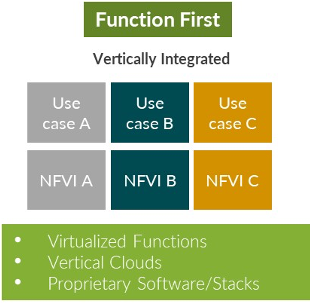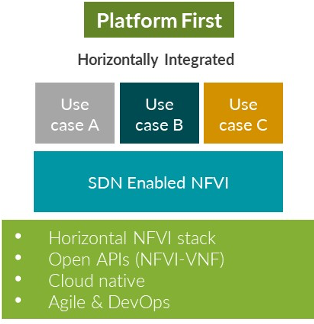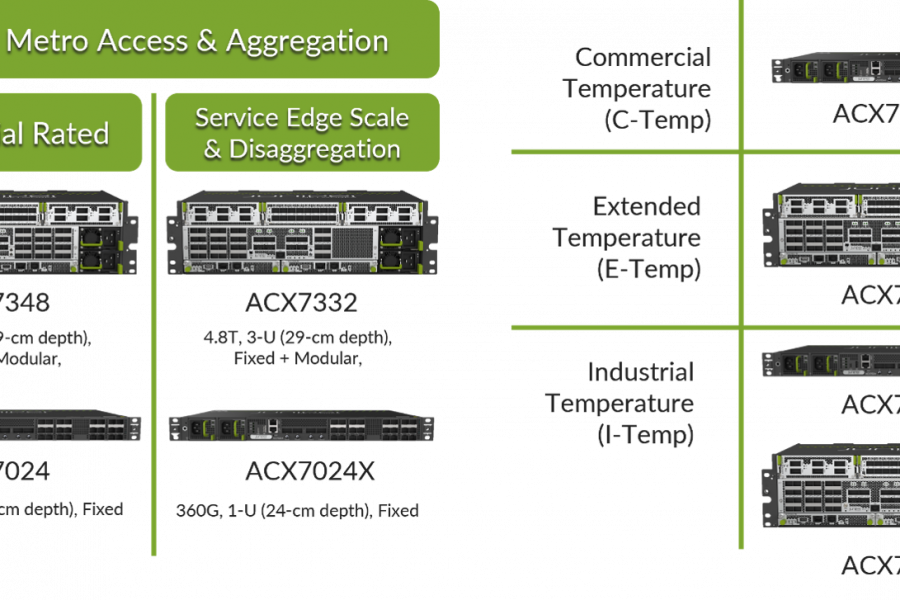It’s been eight years since ETSI published its Network Functions Virtualization (NFV) whitepaper and while many major telecom operators have production telco clouds, those operators are growing increasingly frustrated with the results. According to an STL Partners survey among 20 of the top global telecom operators, the majority of those interviewed felt the technology works, but is not delivering the promised telco cloud value of being open and vendor-neutral, with ubiquitous monitoring at-scale, performant, cost-optimized and agile with innovation delivered through automation. STL Partners concluded that it is not the telco cloud vision or technology that is the problem, rather it is “how the technology has been deployed, both in terms of the technical architecture and how the telco has organized itself to operate it.”[1]
Focusing on deployment, there are different approaches to unlock the potential of a telco cloud, but most deployments fall into two main categories: ‘function-first’ and ‘platform-first’. While there is no definitive list of factors that unerringly indicate the path an operator will take, we do know that the state of their technology, the depth of their technical expertise and the maturity of their operational processes figure prominently in the decision. As they develop their telco cloud muscle, operators are simultaneously pressured to deliver within tight timelines and daunted to drive a corporate-wide telco cloud project. As a result, many operators – nearly 75% of those surveyed by STL Partners – bounded their risk by taking a function-first approach where most found the cons far outweighed the pros.
Function-First
Function-first clouds are frequently owned and driven at the departmental level with the singular goal of virtualizing a specific service. This focus, likely on a network function such as vEPC or vIMS, allows operators to contain the project’s scope to quickly deliver a new, virtualized implementation of a legacy service. Initially, many network operators took a ‘do-it-yourself’ approach, attempting to self-integrate all the hardware and software elements of a multi-vendor telco cloud. However, after feeling challenged by the complexity to integrate software components and protocols across a variety of VNF and platform APIs, most operators turned to the VNF vendors themselves to design, build and integrate the solution on their behalf. 
Given the opportunity, VNF vendors built closed, vertically integrated clouds using their own software components with tightly coupled hardware and software server platforms using SR-IOV to support and optimize the VNF. Servers were often dedicated to specific applications or services, eliminating any of the workload elasticity and scale-out capabilities expected from a cloud deployment. As a result, operators achieved virtualization through the implementation of multiple, parallel cloud environments, one for each VNF, but failed to achieve the open, ubiquitous and flexible cloud platform they envisioned.
Platform-First
Platform-first is an alternative and strategic, top-down approach to develop an open and flexible cloud architecture that is deployed to any operator location and designed to support all present and future cloud computing needs. At its core is an integrated, horizontal software stack that integrates the Virtualized Infrastructure Manager (VIM), software defined networking (SDN), automation and security into a single Network Function Virtualization Infrastructure (NFVI). For example, Juniper’s Contrail Cloud pre-integrates Juniper’s Contrail Networking SDN with Red Hat’s OpenStack and OpenShift environments to deliver the industry’s premier horizontal NFVI cloud platform. By integrating these software elements into a single architecture, life cycle management of the cloud is simplified, allowing operations teams to focus on managing revenue-generating applications and services as opposed to managing cloud infrastructure.
 Unlike function-first, these platform-first clouds act as services platforms, with horizontal alignment to support any and all workloads: IT workloads, network functions, enterprise services, hosted content and operator-developed digital services. Through embedded automation and orchestration, compute, storage and networking are easily deployed to any location in the operator’s network with the flexibility and elasticity to support the dynamic workload requirements of a telco cloud. As a result, operators can shift and scale platform resources to meet the business and service needs of all stakeholders, including internal consumers, external customers, and partners.
Unlike function-first, these platform-first clouds act as services platforms, with horizontal alignment to support any and all workloads: IT workloads, network functions, enterprise services, hosted content and operator-developed digital services. Through embedded automation and orchestration, compute, storage and networking are easily deployed to any location in the operator’s network with the flexibility and elasticity to support the dynamic workload requirements of a telco cloud. As a result, operators can shift and scale platform resources to meet the business and service needs of all stakeholders, including internal consumers, external customers, and partners.
How to choose your cloud-first approach for 5G?
If telco cloud outcomes were centered on delivering a virtual facsimile of a legacy service, function-first would be the path to success. But 5G opens the door to a whole new set of low latency, high capacity applications such as 4K/8K streaming and gaming services, connected vehicles, remote surgery, AR/VR and mixed reality that can only be delivered from a highly distributed edge. To capitalize on the fleet of valuable edge real estate, operators need the agility to develop, deploy and auto scale any new service or application in a consistent way and launch that service across multiple or even simultaneous locations to deliver a ubiquitous experience to their end users. Developing, distributing and managing multiple, VNF-specific function-first clouds throughout an operator’s edge network is simply untenable. Virtualization is certainly a critical pillar of the telco cloud foundation but, as a standalone technology, will not deliver any tangible cloud outcomes. That is where a platform-first approach wins.
What does it take to build future-proof platform-first clouds?
While the platform-first approach is the foundation of a strategic centralized or distributed cloud environment, it relies on more than software solutions alone. It entails an ecosystem of hardware, software, security, analytics and automation technologies that need to operate as a homogeneous platform to meet contracted SLAs. In addition, telco clouds have a unique challenge from their data center cousins in that they must deliver the network functions (VNFs) that are the lifeblood of the operator’s current revenue profile while simultaneously hosting the emerging enterprise, government and consumer workloads that are at the forefront of the $3.5 Trillion 5G market opportunity [source: Ericsson]. As a result, telco clouds are required to host a diverse set of custom ASICs, merchant silicon, GPU and other hardware-assisted forwarding platforms in addition to the traditional x86 servers used for data center workloads. Also, to realize its full potential for digital transformation, telco cloud requires cutting-edge technology, optimized human expertise and processes to automate at-scale.
Building upon platform-first principles, a cloud-first model takes a strategic, top-down approach to the entire telco cloud eco-system, including the forwarding, underlay, overlay, software, security, automation and orchestration planes. It’s a model for cloudifying the central office into a true telco cloud with on-demand economics. Services are assigned to the ‘best fit’ compute based on performance, scale, latency, jitter and resiliency demands of the SLA. Disaggregated CUPS infrastructure services for 4G, 5G and broadband requiring high-speed ASIC-based user planes can leverage a common cloud infrastructure, connected across a high-speed IP fabric, and sit alongside server hosted control plane services, enterprise workloads and operator-owned digital services. SDN, AI/ ML telemetry, automation, security and IP fabric technologies and protocols are shared across virtual and physical layers to eliminate complexity by designing interoperability, unified management and operations into the integrated solution.
Why partner with Juniper for your telco cloud journey?
Juniper’s unique cloud-first approach is a key pillar to enable service provider transformation towards a ‘Cloud + 5G + AI’ era. By combining our deep networking and software expertise with the use of open source software, standard protocols and open APIs, we’re able to deliver a universal, open and agile cloud architecture that extends to the edge for rapid service innovation and delivery.
With support for build-or-managed cloud business models and hybrid use case-based deployment models, we ensure on-demand economics that help service providers’ bottom line as they scale.
Our full-stack automation portfolio simplifies operations and provides assured service experience across a unified physical and virtual cloud environment.
Learn how Juniper can help you build a 5G network powered by a cloud-first telco cloud. Our telco cloud solutions include:
- Massively scalable, high performance IP fabrics built on MX-series, QFX-series and PTX-series
- Pre-integrated, horizontal and cloud native NFVI software stack with Contrail Cloud
- AI and ML driven telemetry and analytics through Contrail Insights and HealthBot
- End-to-end connected security with Contrail Security and SRX-series
- Declarative, intent-based automation through Contrail Networking
- Open source networking and open APIs through our leadership with Tungsten Fabric, CNTT and Akraino
[1] STL Partners Whitepaper: Telco Cloud: why it hasn’t delivered, and what must change for 5G



